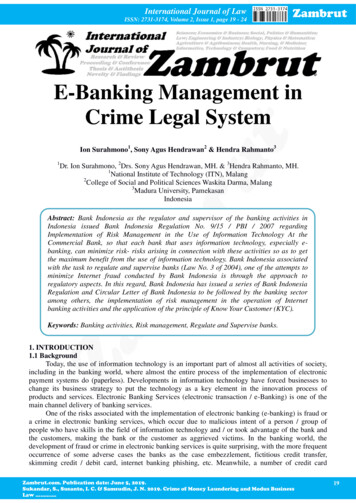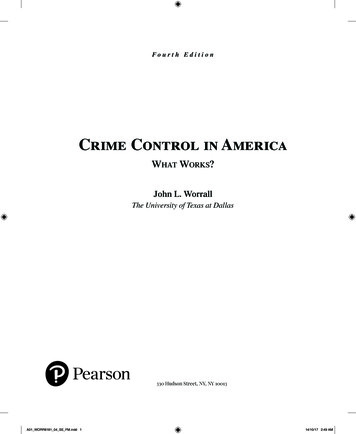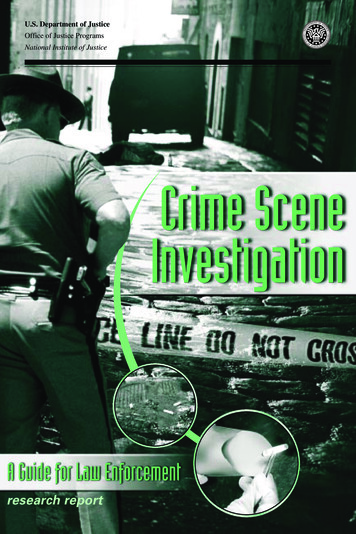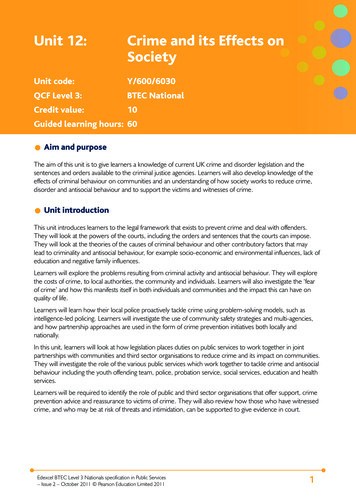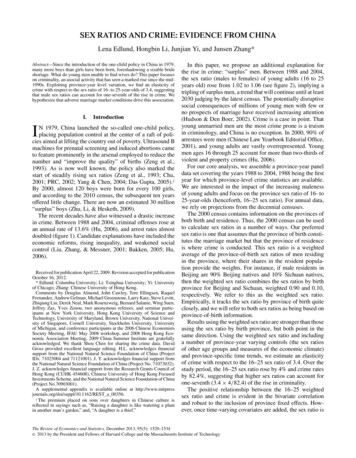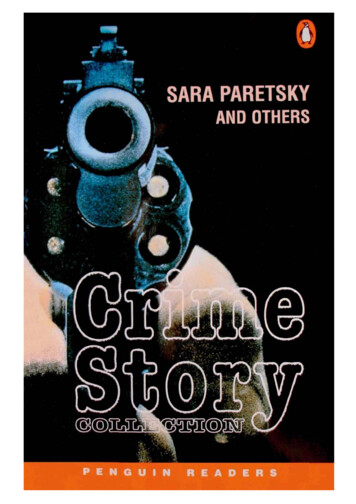
Transcription
Crime Story CollectionLevel 4Retold by John and Celia TurveySeries Editors: Andy Hopkins and Jocelyn Potter
Pearson Education limitedEdinburgh Gate, Harlow,Essex CM20 2JE, Englandand Associated Companies throughout the world.ISBN 0 582 419190This compilation first published in Longman Fiction 1998This edition first published 1999NEW EDITION5 7 9 10 8 6The story “Three is a Lucky Number” Margery Allingham is reproduced bypermission of Curtis Brown, London on behalf of P. & M.Youngman Carter Ltd.The story “Full Circle” by Sue Grafton is reprinted with the permission of AbnerStein, London. The story “How’s Your Mother?” Simon Brett 1980 is from A Box ofTricks, published by Victor Gollancz Ltd. The story “At the Old Swimming Hole” 1986 Sara Paretsky was first published in Mean Streets: The Second Private EyeWriters of America Anthology, edited by Robert J. Randisi, published by MysteriousPress. All rights reserved. First published in the UK by Hamish Hamilton Limited.The Patricia Highsmith story “Slowly, Slowly in the Wind” was first published inEllery Queens Mystery Magazine 1976. Copyright 1993 Diogenes Verlag AG,Zurich. The Patricia Highsmith story “Woodrow Wilsons Neck Tie” was firstpublished in Ellery Queen’s Mystery Magazine 1972. Copyright 1993 DiogenesVerlag AG, Zurich. The story “The Absence of Emily” by Jack Ritchie is reprintedwith kind permission of the Larry Sterring & Jack Byrne Literary Agency, Milwaukee,United States of America. The story “The Inside Story” 1993 Colin Dexter. Thisabridgement and simplification Addison Wesley Longman Limited 1997.This edition copyright Penguin Books Ltd 1999Illustrations by Les EdwardsCover design by Bender Richardson WhiteSet in 11/14pt BemboPrinted in ChinaSWTC/05All rights reserved; no part of this publication may be reproduced, storedin a retrieval system, or transmitted in any form or by any means,electronic, mechanical, photocopying, recording or otherwise, without theprior written permission of the Publishers.Published by Pearson Education Limited in association withPenguin Books Ltd, both companies being subsidiaries of Pearson PlcFor a complete list of the titles available in the Penguin Readers series please write to your localPearson Education office or to: Penguin Readers Marketing Department.Pearson Education. Edinburgh Gate. Harlow. Essex CM20 2JE.
ContentspageIntroductionvThree Is a Lucky Number Margery Allingham1Full Circle Sue Grafton9How's Your Mother?Simon Brett21At the Old Swimming Hole Sara Paretsky32Slowly, Slowly in the Wind Patricia Highsmith42Woodrow Wilson s Tie Patricia Highsmith54The Absence of Emily Jack Ritchie65The Inside Story Colin Dexter74Activities93
IntroductionThis collection contains eight murder stories written by some ofthe finest British and American mystery writers of the twentiethcentury. Many, like Colin Dexter and Patricia Highsmith, are bestknown for their full-length works while others, like Jack Ritchie,specialize in the short story In some of these stories, like SaraParetsky’s ‘At the Old Swimming Hole’, we follow the actionthrough the eyes of the person who is trying to solve the crime.Other stories are told from the point of view of the criminal; asreaders of Patricia Highsmith’s ‘Woodrow Wilson’s Tie’, we sharethe murderer’s thoughts as well as his actions.English mystery writer Margery Allingham (1904-66) wasborn in London. She followed other members of her family intoa life of writing, producing her first mystery story in 1927. Shealso wrote about social history. In ‘Three Is a Lucky Number’ wemeet Ronald Torbay, who is making careful preparations for histhird murder. But will he succeed?Born in Kentucky in 1940, Sue Grafton, who now lives inCalifornia, has won many prizes for her crime stories. KinseyMillhone, a strong, intelligent female private detective with agood sense of humour, is the main character in her books andshort stories. ‘Full Circle’ takes place in the imaginary town ofSanta Teresa in California. It seems that there has been a terriblecar accident. But was it really an accident?British crime writer Simon Brett was born in 1945. Afterstudying at Oxford University, he worked as a producer for BBCradio and London Weekend Television. He has written a numberof radio and TV plays in addition to his books and short stories.Humphrey Partridge, the main character in ‘How’s YourMother?’, lives alone with his sick mother. But nobody ever seesv
her, and when the house burns down she cannot be found.Where has she gone?Sara Paretsky, born in Iowa in 1947, did a variety of jobs afterleaving university before becoming a full-time writer. She haswon many prizes for her crime writing and is particularly wellknown for her stories about V. I. Warshawski, a female privatedetective. In ‘At the Old Swimming Hole’, a woman is shot. V. I.follows the clues, but who is actually following who?Patricia Highsmith (1921-95), who also wrote under the nameClaire Morgan, was from Texas, although she lived in Europe formuch of her later life. Her first book, Strangers on a Train (1950),was very successful and was made into a film by AlfredHitchcock. She too won many writing prizes and two of herstories are included in this collection. ‘Slowly, Slowly in theWind’ tells the story of an argument between neighbours thatgets out of control. In ‘Woodrow Wilson’s Tie’ a young deliveryboy visits the waxworks and has a strange idea, but who willbelieve him?American short story writer John George Reitci (1922-83)wrote under the name of Jack Ritchie. He was educated inWisconsin, served in the United States Army, and wrote his beststories in the 1960s and 1970s. These stories have been reprintedmany times in collections. A number of unusual detectives appearin his mystery stories; often they are not very good at detectivework, and find the right solution by accident. In The Absence ofEmily’, Jack and Emily live next door to Emily’s sister, Millicent.When Emily goes away without telling her, Millicent starts toworry. Is it possible that Jack has killed her?Colin Dexter, born in 1930 in Lincolnshire, England, becamea schoolteacher after leaving Cambridge University. He latermoved to Oxford where many of his stories, including theInspector Morse mysteries, take place. Morse works closely withvi
Sergeant Lewis, and the relationship between these two verydifferent men develops with each story. In ‘The Inside Story’, awoman has been murdered. Clues include picture postcards and acrime story written by the dead woman. So who killed her? Andwhy?vii
Three Is a Lucky NumberMargery AllinghamAt five o’clock on a September afternoon Ronald Torbay wasmaking preparations for his third murder. He was being verycareful. He realized that murdering people becomes moredangerous if you do it often.He was in the bathroom of the house that he had recentlyrented. For a moment he paused to look in the mirror. The facethat looked back at him was thin, middle-aged and pale. Darkhair, a high forehead and well-shaped blue eyes. Only the mouthwas unusual – narrow and quite straight. Even Ronald Torbay didnot like his own mouth.A sound in the kitchen below worried him. Was Edythcoming up to have her bath before he had prepared it for her?No, it was all right: she was going out of the back door. From thewindow he saw her disappearing round the side of the houseinto the small square garden. It was exactly like all the othergardens in the long street. He didn’t like her to be alone there.She was a shy person, but now new people had moved into thehouse next door, and there was a danger of some silly womanmaking friends with her. He didn’t want that just now. Each of his three marriages had followed the same pattern. Usinga false name, he had gone on holiday to a place where no oneknew him. There he had found a middle-aged, unattractivewoman, with some money of her own and no family. He hadtalked her into marrying him, and she had then agreed to make awill which left him all her money. Both his other wives had beenshy too. He was very careful to choose the right type of woman:someone who would not make friends quickly in a new place.1
Mary, the first of them, had had her deadly ‘accident’ almostunnoticed, in the bathroom of the house he had rented – a housevery like this one, but in the north of England instead of thesouth. The police had not found anything wrong. The onlyperson who was interested was a young reporter on the localnewspaper. He had written something about death in the middleof happiness, and had printed photographs of Mary’s weddingand her funeral, which took place only three weeks after thewedding.Dorothy had given him a little more trouble. It was not truethat she was completely alone in the world, as she had told him.Her brother had appeared at the funeral, and asked difficultquestions about her money. There had been a court case, butRonald had won it, and the insurance company had paid him themoney.All that was four years ago. Now, with a new name, a newlyinvented background, and a different area to work in, he feltquite safe.From the moment he saw Edyth, sitting alone at a little tablein the restaurant of a seaside hotel, he knew she was his next‘subject’. He could see from her face that she was not happy. Andhe could also see that she was wearing a valuable ring.After dinner he spoke to her. She did not want to talk at first,but in the end he managed to start a conversation. After that,everything went as he expected. His methods were old-fashionedand romantic, and by the end of a week she was in love with him.Her background was very suitable for Ronald’s purpose. Afterteaching at a girls’ school for ten years, she had gone home tolook after her sick father and had stayed with him until he died.Now, aged forty-three, she was alone, with a lot of money, andshe didn’t know what to do with herself.Five weeks after they met, Ronald married her, in the townwhere they were both strangers. The same afternoon they both2
made a will leaving all their property to each other. Then theymoved into the house which he had rented cheaply because theholiday season was at an end. It was the most pleasant of hismarriages. He found Edyth a cheerful person, and even quitesensible – except that it was stupid of her to believe that a manwould fall in love with her at first sight. Ronald knew he mustnot make the mistake of feeling sorry for her. He began to makeplans for ‘her future’, as he called it.Two things made him do this earlier than he intended. Onewas the way she refused to talk about her money. She kept all herbusiness papers locked in a desk drawer, and refused to discussthem. His other worry was her unnecessary interest in his job.Ronald had told Edyth that he was a partner in an engineeringcompany, which was giving him a long period of absence. Edythaccepted the story, but she asked a lot of questions and wanted tovisit his office and the factory.So Ronald had decided that it was time to act.He turned from the window; and began to run water into thebath. His heart was beating loudly he noticed. He didn't like that.He needed to keep very calm.The bathroom was the only room they had painted. He haddone it himself soon after they arrived. He had also put up thelittle shelf over the bath which held their bottles and creams anda small electric heater. It was a cheap one, with two bars, and itwas white, like the walls, and not too noticeable. There was noelectric point in the bathroom, but he was able to connect theheater to a point just outside the door.He turned on the heater now, and watched the bars becomered and hot. Then he went out of the room. The controls for allthe electricity in the house were inside a cupboard at the top ofthe stairs. Ronald opened the door carefully and pulled up thehandle which turned off the electricity. (He had a cloth over hishand, so that he would not leave fingerprints.)3
Back in the bathroom the bars of the heater were turningblack again. Still using the cloth, he lifted the heater from theshelf and put it into the bath water, at the bottom end of thebath. Of course, you could still see it. It looked as if it had fallenoff the shelf by accident.Edyth was coming back from the garden: he could hear hermoving something outside the kitchen door. He pulled a smallplastic bottle out of his pocket and began to read again thedirections on the back.A small sound behind him made him turn suddenly. There wasEdyth’s head, only two metres away, appearing above the flat roofof the kitchen which was below the bathroom window. She wasclearing the dead leaves from the edge of the roof She must bestanding on the ladder which was kept outside the kitchen door.He stayed calm. ‘What are you doing there, dear?’Edyth was so surprised that she nearly fell off the ladder. ‘Oh,you frightened me! I thought I’d just do this little job before Icame to get ready.’‘But I’m preparing your beauty bath for you.’‘It’s kind of you to take all this trouble, Ronald.’‘Not at all. I’m taking you out tonight and I want you to lookas nice as – er – possible. Hurry up, dear. The bubbles don’t lastvery long, and like all these beauty treatments, this one’sexpensive. Go and undress now, and come straight here.’‘Very well, dear.’ She began to climb down the ladder.Ronald opened the little bottle, and poured the liquid into thebath. He turned on the water again, and in a moment the bathwas full of bubbles, smelling strongly of roses. They covered thelittle heater completely; they even covered the sides of the bath.Edyth was at; the door. ‘Oh Ronald! It’s all over everything –even on the floor!’That doesn’t matter. You get in quickly before it loses itsstrength. I’ll go and change now. Get straight in and lie down. It4
He turned on the water again . . .
will give your skin a bit of colour!’He went out and paused, listening. She locked the door, as heexpected. He walked slowly to the electricity box, and forcedhimself to wait another minute.‘How is it?’ he shouted.‘I don’t know yet. I’ve only just got into the bath. It smellsnice.’His hand, covered with the cloth, was on the controls.‘One, two . . . three,’ he said, and pulled the handle down. Asmall explosion from the electric point behind him told him thatthe electricity had gone off. Then everything was silent.After a time he went and knocked on the bathroom door.‘Edyth?’There was no answer, no sound, nothing.Now he had to prepare the second stage. As he knew well, thiswas the difficult bit. The discovery of the body must be made, butnot too soon. He had made that mistake with Dorothy’s‘accident’, and the police had asked him why he had got worriedso soon. This time he decided to wait half an hour before hebegan to knock loudly on the bathroom door, then to shout for aneighbour and finally to force the lock.There was something he wanted to do now. Edyth’s leatherwriting-case, which contained all her private papers, was in thedrawer where she kept her blouses. He had discovered it sometime ago, but he had not forced the lock open because thatwould frighten her. Now there was nothing to stop him.He went softly into the bedroom and opened the drawer. Thecase was there. The lock was more difficult than he expected, buthe finally managed to open the case. Inside there were somefinancial documents, one or two thick envelopes and, on top ofthese, her Post Office Savings book.He opened it with shaking fingers, and began reading thefigures – 17,000 . . . 18,600 . . . 21,940 . . . He turned over a6
page, and his heart jumped wildly. On 4th September she hadtaken almost all the money out of her savings account!Perhaps it was here, in these thick envelopes? He opened oneof them; papers, letters, documents fell on the floor.Suddenly he saw an envelope with his own name on it, inEdyth’s writing. He pulled it open, and saw in surprise that thedate on the letter was only two days ago.Dear Ronald,If you ever read this, I am afraid it will be a terrible shock to you. Ihoped it would not be necessary to write it, but now your behaviourhas forced me to face some very unpleasant possibilities.Did you not realize, Ronald, that any middle-aged woman who hasbeen rushed into marriage to a stranger will ask herself about herhusband’s reason for marrying her?At first I thought I was in love with you, but when you asked me tomake my will on our wedding day, I began to worry. And then, whenyou started making changes to the bathroom in this house, I decided toact quickly. So I went to the police.Have you noticed that the people who have moved into the housenext door have never spoken to you? Well, they are not a husband andwife, but a police inspector and a policewoman. The policewomanshowed me two pieces from old newspapers, both about women whohad died from accidents in their baths soon after their marriages. Bothpieces included a photograph of the husband at the funeral. They werenot very clear, but I was able to recognize you. So I realized that it wasmy duty to agree to do what the Inspector asked me to do. (The policehave been looking for the man since the photographs were given tothem by your second wife’s brother.) The Inspector said the policeneeded to be sure that you were guilty: you must be given theopportunity to try the crime again. That’s why I am forcing myself to bebrave, and to play my part.I want to tell you something, Ronald. If one day you lose me, out of7
the bathroom, I mean, you will find that I have gone but over thekitchen roof, and am sitting in the kitchen next door. I was stupid tomarry you, but not quite as stupid as you thought,Yours,EDYTH.Ronald’s mouth was uglier than ever when he finished readingthe letter. The house was still quiet. But in the silence he heardthe back door open suddenly, and heavy footsteps rushed up thestairs towards him.8
Full Circle Sue GraftonThe accident happened on a Friday afternoon, as I was drivinghome. The traffic was moving quickly along the Santa Teresafreeway and my own little Volkswagen was running well, althoughit’s fifteen years old. I was feeling good. I’d just solved a difficultcase, and I had a cheque in my handbag for four thousand dollars.That’s good money, for a female private detective working forherself.The sun shone down on the freeway out of a cloudlessCalifornia sky. I was driving in the middle lane. Looking into thedriving mirror, I saw a young woman in a small white carcoming up behind me in the fast lane. A bright red Porsche wasclose behind her, and I guessed she wanted to move into themiddle lane in front of me to let it pass, so I reduced my speed.Coming up on my right was a dark blue Toyota. While I waslooking in the mirror I heard a loud noise, a bit like a gunshot.I turned my attention back to the road in front of me.Suddenly the small white car moved back into the fast lane. Itseemed to be out of control. It hit the back of the red Porsche,ran into the fence in the centre of the freeway, and then backagain into the road in front of me. I put my foot down hard tobring the Volkswagen to a stop. At that moment a greenMercedes suddenly appeared from nowhere, and hit the side ofthe girl’s car, sending it right off the road. Behind me all the carswere trying to stop – I could hear them crashing into each other.It was all over in a moment. A cloud of dust from the side ofthe road showed where the girl’s car had come to rest. It had hitone of the posts of a road sign, and the broken sign was nowhanging across her car roof.I left my car at the side of the road and ran towards the white9
car, with the man from the blue Toyota close behind me. Thegirl’s head had gone through the front window. She wasunconscious, and her face was covered in blood. I couldn’t openthe car door, but the man from the Toyota forced it open andreached inside.‘Don’t move her,’ I said. ‘Let the ambulance people do it.’ Itook off my coat, and we used it to stop the blood from the worstof her cuts. He was a man of twenty-four or twenty-five, withdark hair and anxious dark eyes.Someone behind me was asking for help, and I realized thatother people had been hurt in the accident as well. The driverfrom the green Mercedes was already using the telephone at theroadside, to call the ambulance and police, I guessed. The driverof the red Porsche just stood there, unable to move from shock. Ilooked back at the young man from the Toyota, who was pressingthe girl’s neck. ‘She seems to be alive,’ he said.I left him with the girl, and went to help a man with a brokenleg.By the time the police and the ambulance arrived, a smallcrowd of drivers had stopped their cars to look, as if a roadaccident was some kind of sports event. I noticed my friend JohnBirkett, a photographer from the local newspaper. I watched asthe girl was carried into the ambulance. Then, with some of theother drivers, I had to tell a policeman what I had seen.When I read in the newspaper next morning that the girl haddied, I was so upset that I felt sick. There was a short piece abouther. Caroline Spurrier was twenty-two, a student in her final yearat the University of California, Santa Teresa. She came fromDenver, Colorado. The photograph showed shoulder-length fairhair, bright eyes and a happy smile. I could feel the youngwoman’s death like a heavy weight on my chest.My office in town was being painted, so I worked at homethat next week. On Thursday morning there was a knock at the10
‘Don’t move her.’
door. I opened it. At first I thought the dead girl was alive again,and standing on my doorstep. But then I realized that this was awoman in her forties.‘I’m Michelle Spurrier,’ she said. ‘I understand you saw mydaughter’s accident.’‘Please come in. I’m so sorry about what happened.’She couldn’t speak at first, then the words came slowly ‘Thepolice examined Caroline’s car, and found a bullet hole in thewindow on the passenger side. My daughter was shot.’ She beganto cry. When she was calmer I asked, ‘What do the police sayabout it?’‘They’re calling it murder now. The officer I talked to thinksit’s one of those freeway killings – a crazy man shooting at apassing car, for no special reason.’‘They’ve had enough of those in Los Angeles,’ I said.‘Well, I can’t accept that. Why was she on the freeway insteadof at work? She had a job in the afternoons. They tell me she leftsuddenly without a word to anyone.’‘Where did she work?’‘At a restaurant near the university. She’d been working therefor a year. The manager told me a man had been annoying her.Perhaps she left to get away from him.’‘Did he know who the man was?’‘Not really. They had been out together. He kept coming tosee her in the restaurant, calling her at all hours, causing a lot oftrouble. Lieutenant Dolan tells me you’re a private detective – Iwant you to find out who’s responsible for her death.’‘Mrs Spurrier, the police here are very good at their job. I’msure they’re doing everything possible.’‘I’m not so sure. But I have to fly back to Denver now Myhusband is very ill and I need to get home. I can’t go until Iknow someone here is looking into this. Please.’I said I would do it. After all, I already had a strong interest in12
the case. ‘I’ll need a few names,’ I said.She gave me the names of the girl who shared Caroline’s roomand the restaurant where she’d worked.Usually I try to keep out of cases that the police are workingon. Lieutenant Dolan, the officer responsible for murder cases, isnot fond of private detectives. So I was surprised that he’d sentMrs Spurrier to me.As soon as she left, I drove over to the police station, where Ipaid six dollars for a copy of the police report. Lieutenant Dolanwasn’t in, so I spoke to Emerald, the secretary who works in theRecords Department.‘I’d like a bit of information on the Spurrier accident. Didanybody see where the shot was fired from?’‘No, they didn’t.’I thought about the man in the red Porsche. He’d been in thelane to my left, just a few metres ahead of me when the accidenthappened. The man in the Toyota might be a help as well. ‘Whatabout the other witnesses? There were five or six of us there.Who’s been questioned?’Emerald looked angry. ‘You know I’m not allowed to give outinformation like that!’‘Come on, Emerald. Dolan knows I’m doing this. He told MrsSpurrier about me. Just give me one name.’‘Well . . . Which one?’ Slowly she got out some papers.I described the young man in the Toyota, thinking she couldfind him in the list of witnesses by his age.She looked down the list. ‘Uh-oh! The man in the Toyota gavea false name and address. Benny Seco was the name, but I guesshe invented that. Perhaps he’s already wanted by the police.’I heard a voice behind me. ‘Well, well. Kinsey Millhone. Hardat work, I see.’I turned to find Lieutenant Dolan standing there, his hands inhis pockets. I smiled brightly. ‘Mrs Spurrier got in touch with me13
and asked me to find out more about her daughters death. I feelbad about the girl. What’s the story on the missing witness?’‘I’m sure he had a reason for giving a false name,’ said Dolan.‘Did you talk to him yourself?’‘Just for a few moments, but I’d know him if I saw him again.Do you think he could help us?’‘I’d certainly like to hear what he has to say. The otherwitnesses didn’t realize that the girl was shot. I understand he wasclose enough to do himself.’‘There must be a way to find him, don’t you think?’‘No one remembers much about the man except the car hedrove. Toyota, dark blue, four or five years old.’‘Would you mind if I talked to the other witnesses? I mightget more out of them because I was there.’He looked at me for a moment, and then gave me the list.‘Thanks. This is great. I’ll tell you what I find out.’I drove to the restaurant where Caroline Spurrier had worked.I introduced myself to the manager, and told him I was lookinginto Caroline’s death.‘Oh, yes, that was terrible. I talked to her mother.’‘She told me you said something about a man who wasannoying Caroline. What else can you tell me?’‘That’s about all I know. I never saw the man myself. She wasworking nights for the last two months. She just went back toworking days to try to get away from him.’‘Did she ever tell you his name?’‘Terry, I think. She really thought he was crazy’‘Why did she go out with him?’‘She said he seemed really nice at first, but then he got veryjealous. He used to follow her around all the time, in a greenFord car. In the end, I guess he was completely crazy Heprobably came to find her at the restaurant on Friday afternoon,and that’s why she left.’14
I thanked him, and drove over to the university houses whereCaroline had lived.The girl who had shared her room was busy packing things inboxes. Her name was Judy Layton. She was twenty-two, a Historystudent whose family lived in the town. When I asked why shedidn’t live at home, she explained that she had a difficultrelationship with her mother.‘How long did you know Caroline?’‘About a year. I didn’t know her well.’I looked at the boxes. ‘So you’re moving out?’‘I’m going back to my parents’ house. It’s near the end of theschool year now. And my parents are away for a month, inCanada. My brother’s coming to help me move.’‘Did Caroline have a boyfriend?’‘She went out with lots of boys.’‘But no one special?’She shook her head, not looking at me.I tried again. ‘She told her mother about a man who annoyedher at work. They’d been going out together. They’d just finisheda relationship. I expect she told you about him?’‘No, she didn’t. She and I were not close. She went her wayand I went mine.’‘Judy, people get murdered for a reason. There was somethinggoing on. Can’t you help me?’‘You don’t know it was murder. The policeman I talked to saidperhaps it was a crazy man in a passing car.’‘Her mother doesn’t agree.’‘Well, I can’t help. I’ve told you everything I know.’I spent the next two days talking to Caroline’s teachers andfriends. She seemed to be a sweet girl, well-liked by everyone.But I didn’t get any useful information. I went back to the list ofwitnesses to the accident, talking to each in turn. I was stillinterested in the man with the Toyota. What reason could he have15
‘What’s this about?’
for giving a false name? I didn’t seem to be making any progress.Then an idea came to me as I was looking at the newspaperpicture of the crashed car. I suddenly remembered John Birkett atthe scene of the crash, taking pictures. Perhaps he had one of theman in the Toyota? Twenty minutes later I was in Birkett’s officeat the Santa Teresa News, looking at the photographs.‘No good,’ John said. ‘No clear pictures of him.’‘What about his car?’John pulled out another photo of Caroline’s car, with theToyota some distance behind.‘Can you make it bigger?’‘Are you looking for anything special?’‘The number plate,’ I said.When we had made the photograph bigger we were able toread the seven numbers and letters on the Californianumber plate. I knew I should inform Lieutenant Dolan, but Iwanted to work on this myself. So I telephoned a friend of mineat the Department of Motor Vehicles.The number belonged to a 1984 Toyota, dark blue, and theowner was Ron Cagle, with an address on McClatchy Way.My heart was beating loudly as I rang the bell of the house.When the door was finally opened, I just stood there with mymouth open. Wrong man. This man was tall and fat, with blueeyes and red hair. ‘Yes?’ he said.‘I’m looking for Ron Cagle.’‘I’m Ron Cagle.’‘You are? You’re the owner of a dark blue Toyota?’ I read outthe number of the car.He gave me a strange look. ‘Yes. Is something wrong?’‘Well, I don’t know. Has someone else been driving it?’‘Not for the last six months. See for yourself.’ He led meround the side of the house. There sat a dark blue Toyota, withoutwheels and without an engine. ‘What’s this about?’ he asked.17
‘This car was at the scene of a recent accident where a girl waskilled.’‘Not this one,’ he said. ‘This has been right here, in thiscondition, for six months.’ He looked at
American short story writer John George Reitci (1922-83) wrote under the name of Jack Ritchie. He was educated in Wisconsin, served in the United States Army, and wrote his best stories in the 1960s and 1970s. These storie



